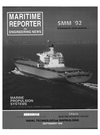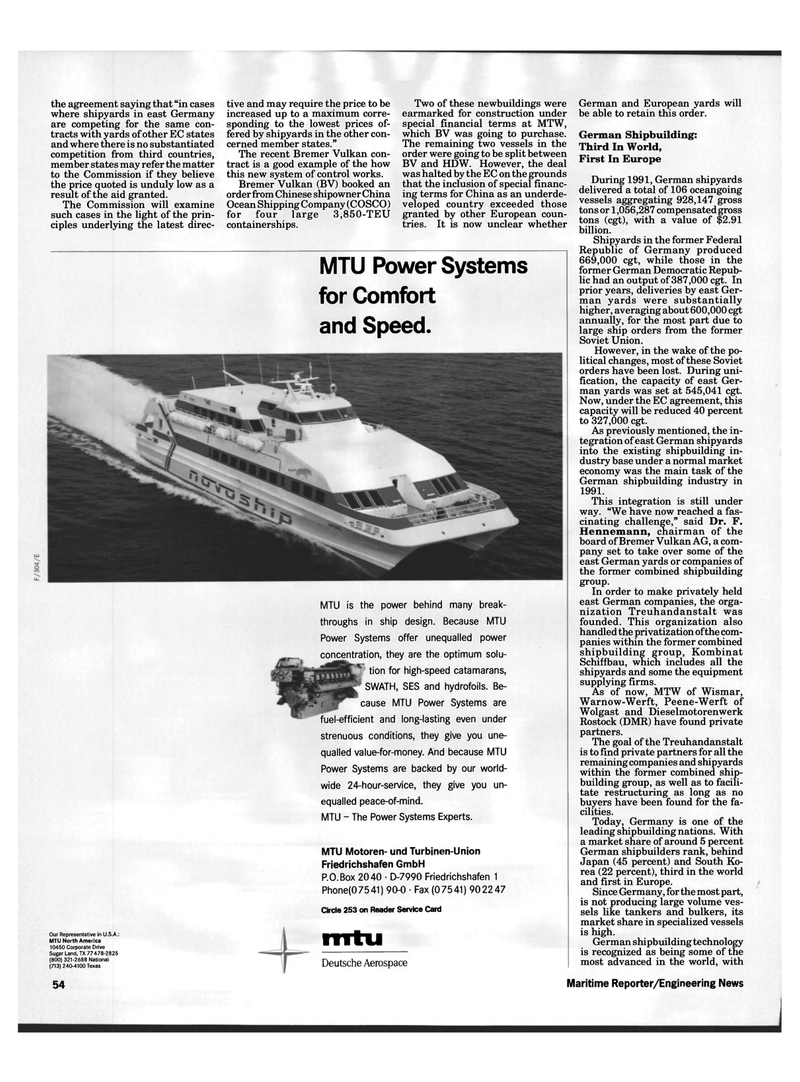
Page 56: of Maritime Reporter Magazine (September 1992)
Read this page in Pdf, Flash or Html5 edition of September 1992 Maritime Reporter Magazine
the agreement saying that "in cases where shipyards in east Germany are competing for the same con- tracts with yards of other EC states and where there is no substantiated competition from third countries, member states may refer the matter to the Commission if they believe the price quoted is unduly low as a result of the aid granted.
The Commission will examine such cases in the light of the prin- ciples underlying the latest direc- tive and may require the price to be increased up to a maximum corre- sponding to the lowest prices of- fered by shipyards in the other con- cerned member states."
The recent Bremer Vulkan con- tract is a good example of the how this new system of control works.
Bremer Vulkan (BV) booked an order from Chinese shipowner China
Ocean Shipping Company (COSCO) for four large 3,850-TEU containerships.
Two of these newbuildings were earmarked for construction under special financial terms at MTW, which BV was going to purchase.
The remaining two vessels in the order were going to be split between
BV and HDW. However, the deal was halted by the EC on the grounds that the inclusion of special financ- ing terms for China as an underde- veloped country exceeded those granted by other European coun- tries. It is now unclear whether
German and European yards will be able to retain this order.
German Shipbuilding:
Third In World,
First In Europe
During 1991, German shipyards delivered a total of 106 oceangoing vessels aggregating 928,147 gross tons or 1,056,287 compensated gross tons (cgt), with a value of $2.91 billion.
Shipyards in the former Federal
Republic of Germany produced 669,000 cgt, while those in the former German Democratic Repub- lic had an output of 387,000 cgt. In prior years, deliveries by east Ger- man yards were substantially higher, averaging about 600,000 cgt annually, for the most part due to large ship orders from the former
Soviet Union.
However, in the wake of the po- litical changes, most of these Soviet orders have been lost. During uni- fication, the capacity of east Ger- man yards was set at 545,041 cgt.
Now, under the EC agreement, this capacity will be reduced 40 percent to 327,000 cgt.
As previously mentioned, the in- tegration of east German shipyards into the existing shipbuilding in- dustry base under a normal market economy was the main task of the
German shipbuilding industry in 1991.
This integration is still under way. "We have now reached a fas- cinating challenge," said Dr. F.
Hennemann, chairman of the board of Bremer Vulkan AG, a com- pany set to take over some of the east German yards or companies of the former combined shipbuilding group.
In order to make privately held east German companies, the orga- nization Treuhandanstalt was founded. This organization also handled the privatization of the com- panies within the former combined shipbuilding group, Kombinat
Schiffbau, which includes all the shipyards and some the equipment supplying firms.
As of now, MTW of Wismar,
Warnow-Werft, Peene-Werft of
Wolgast and Dieselmotorenwerk
Rostock (DMR) have found private partners.
The goal of the Treuhandanstalt is to find private partners for all the remaining companies and shipyards within the former combined ship- building group, as well as to facili- tate restructuring as long as no buyers have been found for the fa- cilities.
Today, Germany is one of the leading shipbuilding nations. With a market share of around 5 percent
German shipbuilders rank, behind
Japan (45 percent) and South Ko- rea (22 percent), third in the world and first in Europe.
Since Germany, for the most part, is not producing large volume ves- sels like tankers and bulkers, its market share in specialized vessels is high.
German shipbuilding technology is recognized as being some of the most advanced in the world, with
MTU Power Systems for Comfort and Speed.
MTU is the power behind many break- throughs in ship design. Because MTU
Power Systems offer unequalled power concentration, they are the optimum solu- tion for high-speed catamarans,
SWATH, SES and hydrofoils. Be- cause MTU Power Systems are fuel-efficient and long-lasting even under strenuous conditions, they give you une- qualled value-for-money. And because MTU
Power Systems are backed by our world- wide 24-hour-service, they give you un- equalled peace-of-mind.
MTU - The Power Systems Experts.
MTU Motoren- und Turbinen-Union
Friedrichshafen GmbH
P.O.Box 2040 • D-7990 Friedrichshafen 1
Phone(07541) 90-0 • Fax (07541) 902247
Circle 253 on Reader Service Card
Our Representative in U.S.A.:
MTU North America 10450 Corporate Drive
Sugar Land, TX 77478-2825 (800) 321-2688 National (713) 240-4100 Texas rrrtvi
Deutsche Aerospace 54 Maritime Reporter/Engineering News

 55
55

 57
57
